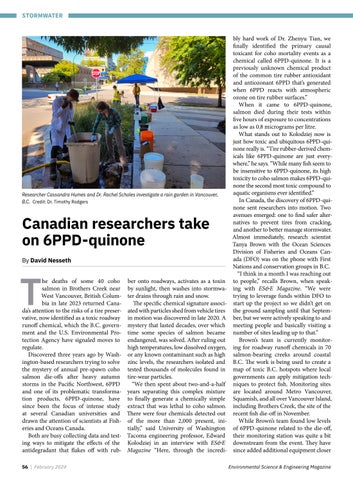STORMWATER
Researcher Cassandra Humes and Dr. Rachel Scholes investigate a rain garden in Vancouver, B.C. Credit: Dr. Timothy Rodgers
Canadian researchers take on 6PPD‑quinone By David Nesseth
T
he deaths of some 40 coho salmon in Brothers Creek near West Vancouver, British Columbia in late 2023 returned Canada’s attention to the risks of a tire preservative, now identified as a toxic roadway runoff chemical, which the B.C. government and the U.S. Environmental Protection Agency have signaled moves to regulate. Discovered three years ago by Washington-based researchers trying to solve the mystery of annual pre-spawn coho salmon die-offs after heavy autumn storms in the Pacific Northwest, 6PPD and one of its problematic transformation products, 6PPD-quinone, have since been the focus of intense study at several Canadian universities and drawn the attention of scientists at Fisheries and Oceans Canada. Both are busy collecting data and testing ways to mitigate the effects of the antidegradant that flakes off with rub56 | February 2024
ber onto roadways, activates as a toxin by sunlight, then washes into stormwater drains through rain and snow. The specific chemical signature associated with particles shed from vehicle tires in motion was discovered in late 2020. A mystery that lasted decades, over which time some species of salmon became endangered, was solved. After ruling out high temperatures, low dissolved oxygen, or any known contaminant such as high zinc levels, the researchers isolated and tested thousands of molecules found in tire-wear particles. “We then spent about two-and-a-half years separating this complex mixture to finally generate a chemically simple extract that was lethal to coho salmon. There were four chemicals detected out of the more than 2,000 present, initially,” said University of Washington Tacoma engineering professor, Edward Kolodziej in an interview with ES&E Magazine “Here, through the incredi-
bly hard work of Dr. Zhenyu Tian, we finally identified the primary causal toxicant for coho mortality events as a chemical called 6PPD-quinone. It is a previously unknown chemical product of the common tire rubber antioxidant and antiozonant 6PPD that’s generated when 6PPD reacts with atmospheric ozone on tire rubber surfaces.” When it came to 6PPD-quinone, salmon died during their tests within five hours of exposure to concentrations as low as 0.8 micrograms per litre. What stands out to Kolodziej now is just how toxic and ubiquitous 6PPD-quinone really is. “Tire rubber-derived chemicals like 6PPD-quinone are just everywhere,” he says. “While many fish seem to be insensitive to 6PPD-quinone, its high toxicity to coho salmon makes 6PPD-quinone the second most toxic compound to aquatic organisms ever identified.” In Canada, the discovery of 6PPD-quinone sent researchers into motion. Two avenues emerged: one to find safer alternatives to prevent tires from cracking, and another to better manage stormwater. Almost immediately, research scientist Tanya Brown with the Ocean Sciences Division of Fisheries and Oceans Canada (DFO) was on the phone with First Nations and conservation groups in B.C. “I think in a month I was reaching out to people,” recalls Brown, when speaking with ES&E Magazine. “We were trying to leverage funds within DFO to start up the project so we didn’t get on the ground sampling until that September, but we were actively speaking to and meeting people and basically visiting a number of sites leading up to that.” Brown’s team is currently monitoring for roadway runoff chemicals in 70 salmon-bearing creeks around coastal B.C. The work is being used to create a map of toxic B.C. hotspots where local governments can apply mitigation techniques to protect fish. Monitoring sites are located around Metro Vancouver, Squamish, and all over Vancouver Island, including Brothers Creek, the site of the recent fish die-off in November. While Brown’s team found low levels of 6PPD-quinone related to the die-off, their monitoring station was quite a bit downstream from the event. They have since added additional equipment closer Environmental Science & Engineering Magazine
